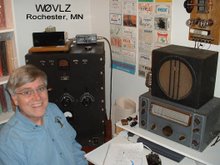





Last week I acquired a 30's vintage National 56 MC transceiver. Read about this model on my web site at http://www.prismnet.com/~nielw/TRM_TRW/TRMpage.htm . The TRM and the wooden cased TRW were two of the first commercially available VHF radios. At only 6"x6"x7.5" and 8.5 pounds it is amazingly heavy for it's size. The two special National transformers add a lot to the weight.
I don't find much information about the TRM. What I've found is from National's 1935 catalog and a 1933 article that, while it doesn't mention it by name, appears to describe the TRM. None of my catalogs mention the TRM or TRW after 1935 but my TRM has a model tag. National didn't but tags on their equipment until after James Millen left in 1938. This one must be a late model.




